101 Ways to Increase Productivity at Work
Introducing the complete list of 101 ways to increase productivity at work.
Successful companies are the ones who find ways to maximize the productivity of its employees.
And successful employees are ones who know how to maximize their own productivity, making them stand out from the crowd.
So without further adieu, here we go!
(Don't forget to share this page if you like it!)
Foods
 1. Avoid Junk Foods
1. Avoid Junk Foods
Everyone knows that to be successful in any aspect of life, your body needs the proper fuel.
Same goes with your professional life.
Ever feel like you are just going through the motions when the clock strikes 3:00 PM? Is it because you ate that massive burrito for lunch, much like every other day? Probably.
But that’s not to say you can never eat that burrito. Work-life expert Andy Core says on his blog,
“When you eat healthy the majority of the time, the effects of junk food will be minimal and your productivity in the workplace will not be affected by sugar highs and lows.”
Power tip: Stash healthy snacks, like raisins and almonds, in your desk drawer. Having them on hand will mean fewer trips to the break room and vending machines.
2. Avoid Heavy Foods
Remember that burrito we talked about in the last section? Much like any burrito, it’s coming back to haunt you.
And now, you’re probably regretting it.
According to Business Insider, “Heavy, calorie-ridden foods like hamburgers and fries will make you sleepy and slow you down at work”.
Lesson here? Stick to leafy greens and foods that are optimum for sustainable energy, like whole grains and natural sugars like fruit, which help with memory and motor coordination.
Power tip: Starting your day off with steel cut oats and mixed berries fulfills three things vital to productivity: Eating breakfast, whole grains and natural sugars
3. Small, frequent meals
Interesting fact: Most people reading this list probably didn’t eat breakfast this morning, and will probably work through their lunch hour, resorting to a bag of chips and a soda out of the vending machine around 2:00.
Not a good idea. Listen up.
People who eat 5-6 meals a day have better productivity at work. Why is that?
Eating frequently keeps the body functioning properly, and gives a steady surge of energy, rather than the peaks that sugar and processed carbohydrates cause.
According to American Express’ Open Forum, “Binge eating is a surefire way to topple your productivity. Instead, focus on consuming 5-6 small meals, each containing fat, protein, carbohydrates and fiber”.
Power Tip: The meals don’t have to be large. A half sandwich and some fruit is the perfect lunch size
4. Bran
Bran has gotten a bad rap over the years as the go-to food of the elderly and “backed” up population.
On the contrary, bran is beneficial to everyone, especially those who have issues with sustaining energy.
Besides the obvious health benefits, like how it lowers cholesterol, risk of heart attack and the free radicals in the body, bran is rich in phenylalanine.
For those who don’t know, phenylalanine deficiency causes confusion, lack of energy, and in extreme cases, anorexia.
Power Tip: “Clean” (low fat, non-processed ingredients, etc.) oatmeal raisin cookies are a tasty way to get oats into your diet. Recipes can be found all over the Internet.
 5. Bananas
5. Bananas
Ah, nature’s most delicious fruit all wrapped up and ready to go with you on the run.
But bananas are more than just scrumptious; they have HUGE impacts on health and productivity.
According to Andy Core, “Vitamin C deficiency is becoming common in the modern world as more and more people develop unbalanced diets… Bananas are satisfyingly filling and much healthier than sugar-filled candy and greasy burgers.”
Power Tip: Make bananas last longer by wrapping the top of them stems in plastic wrap. They keep 3-5 days longer.
6. Almonds
There is a common misconception about almonds, and nuts in general, that make people believe that they aren’t healthy because they contain high levels of fat.
This is simply not true.
Did you know that there is “good” fat and “bad” fat?
Almonds are rich in “good” fats, in fact, these fats actually aid in weight loss. Who knew?
In terms of energy and productivity, almonds are high in riboflavin and L-Carnitine, which boost brain activity and can help prevent Alzheimer’s.
Better brain function equals better work output.
Power Tip: While almonds are healthy, watch out for serving size. Standard serving is 35 pieces, or a small palm full.
7. Broccoli
Movies and television give us the wrong idea when it comes to this super food. Everything portrays children, even adults, turning up their noses and pushing away their plates whenever these little green trees show up.
But did you know it’s a natural energy booster?
Broccoli is packed with iron, which is proven to put your energy into high gear.
Plus, considering its chock full of other vitamins and nutrients, broccoli helps keep your immune system in top shape.
So you can save your sick days for days when you are too “sick” to make it in. Usually super warm and sunny days.
Power tip: Not a fan of steamed broccoli? Eat it raw. Replace chips and other crunchy snacks with raw broccoli and two tablespoons of light dressing. Instant satisfaction
8. Spinach
Much like its cousin broccoli, spinach, and leafy greens in general, are a good option for sustaining energy.
According to MyHealingKitchen, spinach is one of the most nutrient-dense foods on the planet, containing over 13 different essential vitamins and minerals. One half cup of spinach contains over fifty percent of the daily requirement of Vitamin C, with a lot less calories than orange juice or fruit drinks.
As with broccoli, this means healthy immune systems and healthier minds.
And a healthy mind is a terrible thing to waste.
Power Tip: If you aren’t a fan of the taste of spinach, it can be added to just about anything. Try it blended in a morning smoothie for a natural energy kick without the caffeine.
 9. Sweet Potatoes
9. Sweet Potatoes
Did you know yams and sweet potatoes are NOT the same thing? Yams are a denser sweet potato.
If you aren’t like many Americans these days trying to watch their carbohydrates, then sweet potatoes are a great way to boost your energy during the day.
One half of a sweet potato, or 3.5 ounces, packs in 3 grams of fiber, 20 grams of carbs (which if you work out before/after work, is a small amount) and less than one gram of fat.
10. Blueberries
Listen up ladies (and men, no discrimination) not only do blueberries give you the energy to be more productive during those long work days, they also contain resveratrol.
Don’t know what that is? Well, you heard it here first: IT REDUCES WRINKLES!
A natural energy source AND it can give you less wrinkles? Where do we sign up?
Eat a blueberry. In fact, eat a handful of blueberries. They are high in vitamin C, manganese,
fiber and vitamin E. Best part? They are also super low in calories for all you waist watchers.
Power Tip: Pop a handful of blueberries in your morning smoothie or oatmeal.
11. Eggs
We all know that breakfast is the most important meal of the day.
But what do we eat for breakfast to make it last throughout the day?
That’s an easy answer: eggs.
According to Men’s Fitness, “Egg yolks are naturally rich in B-vitamins, which are responsible for converting food into energy and they also have Vitamin D to maintain strong bones. Plus, they’re one of the best sources of protein, which is essential particularly after an intense training session when muscle breakdown occurs the most”.
Or an intense day sorting through files and dealing with office gossip.
Power Tip: This one comes courtesy of Men’s Fitness. Try using one whole egg and 2-3 egg whites to cut down on the fat and cholesterol of your morning meal.
What does all that mean?
Sticking one in the microwave at lunch time will wipe away those early afternoon blues, and keep you satisfied until dinner.
Power Tip: Craving something sweet? A warm sweet potato with a teaspoon of butter or margarine, plus a sprinkling of cinnamon, is a great way to satisfy any sweet tooth.
12. Salmon
Salmon is probably the most common type of fish eaten in America, aside from sushi.
Did you know that pink, flaky fish is actually a proven brain booster?
The Omega 3 fatty acids in salmon help improve memory and brain function, according to the blog, 3 Fat Chicks.
In fact, ingesting salmon regularly has been proven to lower the risk of Alzheimer’s and Parkinson diseases.
In addition to helping brain function, the acids in salmon help with reducing blood sugar, so you won’t experience that 2:00 PM crash you do with most other foods.
Power Tip: Replace your tuna with canned salmon for a salmon salad sandwich.
13. Quinoa
Quinoa gets a pretty bad reputation because of the unfortunate name, but it is emerging as one of the most super foods available.
Quinoa’s health benefits are astounding when compared to other grains. It’s high in protein and an excellent source of riboflavin, which helps reduce migraines by improving energy metabolism in the brain.
Also, for you sufferers of Celiac or gluten intolerance, quinoa is naturally gluten free.
So toss it in your salad, or warm it up in the morning instead of oatmeal. You’ll feel better and have lasting energy.
Power Tip: Quinoa can be popped like popcorn. Also, mixing it in with pudding makes a healthier substitute for rice pudding.
 14. Greek Yogurt
14. Greek Yogurt
Greek yogurt consumption is on the rise in the US. Numerous brands are entering the marketplace giving health conscious consumers a wide array of flavors and textures to choose from.
But aside from being a delicious afternoon snack, greek yogurt packs a healthy punch.
Greek yogurt contains calcium, potassium, protein, zinc and vitamins B6 and B12. In addition to all that goodness, it also contains twice the protein as regular yogurt.
If you decide to replace your typical afternoon snack, whether it be chips or whatever is in the office candy bowl this week, with nonfat, plain greek yogurt, you can expect long lasting, sustaining energy to get you through the work day more alert and ready to take on the world.
Power Tip: Throw in some of the blueberries we talked about earlier, mix up, and enjoy the sweet taste of healthy snacking success
Exercise
Everyone of any age is told that exercise is extremely important for our health, but did you know that it also boosts your productivity and work output? A healthy body promotes a healthy brain, and a healthy brain is the most valuable on-the-job asset.
 15. Exercise Room/Office Gym
15. Exercise Room/Office Gym
Everyone knows that a healthy body equals a healthy mind.
But not everyone has time to head to the gym after a long day at work.
The solution? Office gyms.
Many companies offer in office gyms as a perk to employees, which also gives them a reason to work off the stress of the day during lunch breaks and after they clock out.
Also, many companies leverage the office gym as a hiring perk, recruiting more top notch candidates than companies who do not offer one.
Power Tip: If your company doesn’t offer an office gym, try finding one close to the office. That way, you can easily go after work without too many excuses.
16. Walking Outside
You ever step out of the office for lunch and see all the classy dressed ladies wearing running shoes with their power suits?
Walking at lunch time has become a very common activity amongst office workers.
Not only does it relieve stress and increase blood flow to the brain, workers who step outside the cubicle and into the fresh air have higher morale and are less depressed.
Managers should promote the activity. Employees who walk together generally have better workplace behavior and camaraderie. It also has been proven to reduce turnover and sick leaves.
Power Tip: Many websites offer walking “programs” for you to follow. Just Google “lunch time walking.”
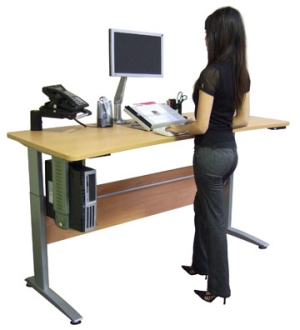 17. Standing While Working
17. Standing While Working
One thing that has been making an impact in the workplace is standing while working. Gone are the days where you are glued to a cheap IKEA desk chair for 8 hours and in with desks made for standing.
Did you know that sitting all day increases your risk of heart disease, blood clots on the brain and a few types of cancer? Even diabetes is a risk! The longer you sit, the more fat and sugar
accumulates in the body.
But just 90 minutes of standing per day can greatly reduce the risk.
What does this have to do with productivity? Simple.
Like we said before in previous tips, any illness to the body will reduce office productivity, whether it is lethargy during the work day, or sick leave being used to treat more serious illnesses.
Power Tip: Suggest switching a few desks around the office to standing desks. The more you stand, the healthier you are.
18. Take the Stairs
This should be a no-brainer when it comes to energy and exercise.
According to Duke University, by climbing 55 flights of stairs per week, there is a significant drop in the mortality rate.
What does that mean?
Taking the stairs instead of the elevator will, in some cases, make you live longer.
This means the longer you live, the more you can work. And, because illness won’t set in so easily, less sick days and more productivity on the job.
Power Tip: Park your car a little further out in the parking lot. It adds a little more cardio to the stair climbing, which burns more calories.
19. Yoga
To some, office yoga seems like a bit of a joke.
But, we aren’t talking about on-the-floor-mat yoga either.
There are simple yoga poses you can do in your chair at your desk that can significantly decrease stress and tension.
Sitting in an office chair for 8 hours a day greatly affects your body’s ability to function properly.
There are a few exercises that you can find here, that every level of yoga practitioner, or non-practitioner, can do.
Power Tip: If you enjoy doing office yoga, expand into a full yoga routine outside of work. The affects will greatly benefit your productivity!
20. The 7 Minute Workout
Although this one option isn’t as well known as some of the others, the 7 minute workout definitely has its advantages.
Using no equipment other than your body, a chair, and a wall, you get a total body workout in, you guessed it, 7 minutes.
Exercise, as we have covered numerous times in this section, increases blood flow throughout the body and allow you to recharge your energy.
Seems like working out would drain your energy, not restore it, huh?
Might as well give it a shot.
Power Tip: The New York Times did a feature on the 7 Minute Workout, with diagrams and break downs of the routine. Find it here.
 21. Biking to Work
21. Biking to Work
Not only is this a good way to get the energy and blood flowing in the AM, it’s also good for the environment!
That is if you live close to your office.
Riding your bike to work is the easiest change you can make that will benefit not only yourself, but everyone around you.
Stress levels will decrease, since you won’t be swearing and yelling sitting in traffic, you can enjoy the fresh air, and the exercise aspect will get the blood flowing to the brain for better productivity throughout the day.
It even helps you lose weight! On average, bike commuters lose 13 pounds their first year!
You might even be able to cancel that gym membership.
Power Tip: A lot of big cities are making biking easy by offering bike shares. One monthly fee and riders get 30-45 minutes of bike use.
Aromatherapy
Everyone knows that scents can trigger a memory, but did you know they can also increase productivity? By filling your cubicle or office with these smells, or investing in a new perfume, your productivity can increase dramatically.
 22. Vanilla
22. Vanilla
Vanilla is probably one of the most commonly found scents out there.
Companies make a killing producing candles, air fresheners, body sprays, etc., all containing the delicious odor.
Vanilla has been proven to give off a sense of comfort, which is perfect for awkward work situations, meetings, or any other time you need those around you to be comfortable.
The more comfortable you are, the less stress you have and that, ladies and gentlemen, is how you increase your workplace productivity.
Power Tip: While most places won’t let you burn candles in the office, try using a wall plug in filled with vanilla scented oil. No fire hazards and the smell will quickly fill your space.
23. Citrus
Whenever we think about lemon, or any citrus scent, we are immediately flooded with images of clean, open spaces where we twirl around and inhale deeply.
Oh wait, that’s a cleaning solution commercial.
Citrus scents are pretty powerful at conjuring up images.
But did you know that it is also a natural productivity booster?
The scent of lemon naturally increases your energy, thus increasing your productivity.
Even better, combining the scent with the actual fruit in your stomach, you will get through the afternoon with a smile on your face and a stack in your outbox.
Power Tip: Recommend the cleaning crew in your office use lemon scented supplies when cleaning common work areas. This way, everyone can benefit!
24. Peppermint
Candy canes, Santa Claus…and productivity?
Not really what comes to mind when you think about peppermint, is it?
Peppermint is one of those all-around useful scents.
Inhaling the scent of peppermint has been proven to make you happier, and eating it helps in preventing/curing headaches and stomach issues.
Luckily, peppermint can be found almost everywhere, no matter the season. So you don’t have to buy a dozen boxes of candy canes to last you throughout the year.
Power Tip: Peppermint candies are a good thing to keep in your desk drawer. Anytime you need a quick pick-me-up or a stomach settler, you’ll always have it on hand.
 25. Jasmine
25. Jasmine
Jasmine is one of the few scents that actually produce a feeling of calm and relaxation.
So if you are facing a tight deadline, the boss is breathing down your neck, or you have a big presentation coming up, jasmine is the perfect scent to calm those shattered nerves.
Bonus: Jasmine has also been proven to help people feel more romantic.
Perfect for those who are trying to lure the cute intern down the hall.
We won’t judge.
Power Tip: Try jasmine based perfumes. This will keep the scent on you and when your body temperature increases, the smell will be released as well.
26. Cinnamon
Here is another scent that makes us warm and fuzzy. Cinnamon brings back memories of
Thanksgivings, fall and warm baked goods.
But, it also has been said to be comforting and give the sense of well being.
Which we can probably attribute to the memories of fresh baked cakes and cookies, served with a glass of milk and a hug from Mom.
Ingesting cinnamon is also excellent for metabolism, which will keep you at a healthy weight,
thus taking less sick days.
Except we don’t recommend eating all those baked goods. It’s counter-productive.
Power Tip: Add a sprinkle of cinnamon to your daily coffee. It adds flavor without the calories and when adding it to another powerful scent, the benefits are amplified.
 27. Rosemary
27. Rosemary
Rosemary is one of the strongest, most recognizable scents in the world.
Known not only for its smell, but also its pungent taste, rosemary has been said to support clarity
of mind and alertness.
Taking a few sniffs of rosemary will make your brain feel less muddled; giving you the focus you need to power through even the most difficult task.
Power Tip: Keep a small jar of rosemary in your drawer and waft it under your nose when you need a pick me up.
Websites to Avoid
Since the invention of the Internet, workplace productivity has been in the spotlight. We have an infinite amount of resources available at our fingertips, and not all of them are beneficial during the workday. Some may seem like common knowledge, but others are shocking productivity sucks.
 28. Online Games
28. Online Games
One of the worst things to happen to workplace productivity is the creation of online gaming websites.
Gone are the days of playing Solitaire or Minesweeper in your cubicle.
Companies like Zynga and Pogo are making gaming during office hours not only easy, but incredibly tempting.
Facebook doesn’t help either. Over 20% of active Facebook users admit to using the site for gaming purposes.
Unfortunately, a majority of them play games during work hours, which can be better used on more productive tasks.
Try to keep the gaming limited to break times.
Power Tip: If your company doesn’t already block websites, ask for it. Blocking gaming websites will remove the temptation.
29. Pornography
Remember before when we said some of the items on this list were going to be common knowledge?
We would have hoped this would be one of them.
But did you know, over 20% of men admit to watching pornography at work?
There are numerous things wrong with watching pornography at work, not to mention the time waster it is.
There are literally thousands of other tasks an office worker can participate in that are more productive than viewing pornography.
We suggest you engage in one of those.
Power Tip: Keep personal business personal. If you wish to view pornography, do it on your personal time, at home, where the legal ramifications are far less if you get caught.
30. Shopping
It’s tempting. Visiting a website to see if you can get a deal on that dress you saw over the weekend or a new TV for the big game on Sunday.
Admit it. We have all spent time online shopping during the work day.
Especially during the holiday season.
In fact, 49% of people used work hours to online shop last holiday.
As you might think, these statistics are biased towards women.
Spending time browsing online sale racks is a major waste of productive time, and it’s difficult not to be sucked into it.
If you find yourself wandering to these websites, try website blocking. Most companies IT departments can block individual websites, making it impossible to access them.
Power Tip: Try leaving your credit cards at home or in the car. Not having the money to purchase may deter the desire to shop.
 31. YouTube
31. YouTube
Good old YouTube.
Since its launch, people have been wasting hours watching videos of cats playing pianos and people falling off skateboards.
Everyone knows what YouTube is and most companies that use website blocking programs have it in their top 10.
While YouTube does have its benefits for productivity (like these videos, found at http://socialwayne.com/2011/01/09/motivational-youtube-videos-increase-productivity-profitability-2011/), the vast majority of time spent on the site is a complete void.
The only advice we can offer is this: Unless you are on a break or your lunch hour, don’t click over. You’ll come back to Earth two hours and 30 cat videos later.
Power Tip: If you use YouTube for music purposes, try using iTunes, Pandora or Spotify. These programs don’t have video, so you won’t be tempted to watch.
32. Social Media
Where would we be if you couldn’t tweet that your shoes hurt, or post a picture of said shoes on Instagram?
Social media is quickly becoming a vital part of life for most people and is slowly leaking into the workplace.
It may seem innocent enough. You get an alert that someone liked your Facebook post, or that someone retweeted a post. But before you know it, you’ve been sucked in and can’t find your way out.
The statistics are shocking. 77% of people check their social media profiles on work time and computers and 7% of work hours are being spent on Facebook. Even Pinterest is a time suck.
Women, on average, spend 77 minutes per day pining recipes and makeup tips.
While some social media use is productive (to say, your Social Media Director), most often times it is time that can be better spent on business related tasks.
Most companies have wised up and added these sites to blocked lists.
Power Tip: Just say no. Turn off your personal phone (yes, your smart phone) when you get to work and make it a rule to only check it on breaks.
33. Sports
Women have Pinterest, men have ESPN.
While that statement may be a little sexist, the fact remains that time is being spent on non-productive tasks, no matter what the site.
Or in this case, office interaction can be included.
Sports and office betting pools are a huge waste of productive time that is often overlooked or forgotten.
As football and hockey season approach, the Internet is abuzz with predictions, trades and most importantly, scores.
Sports, unfortunately, don’t just stay online in the office. Many companies have office betting pools, designed to bring a sense of camaraderie to the office, but instead drain valuable resources.
In fact, 56% of people say they spend over 30 minutes a day (of paid work time) researching information for office betting pools.
Power Tip: If you find yourself spending too much time on office pools or checking sports scores, it might be best to drop out. No bet is worth losing your job over.
 34. Gossip
34. Gossip
Since the dawn of time, someone has been gossiping about someone else.
Even the Bible is chock full of juicy gossip. (Mary was a pregnant VIRGIN?! Yea right!)
Websites like TMZ, People and Just Jared make obtaining celebrity gossip a cinch.
What did Halle Berry wear to the gym yesterday? Why is Kim Kardashian so fat? Is Brad Pitt going bald?
For some reason, we need to know the answers to these questions and we need to know now!
Or so we think.
Power Tip: If you find yourself wandering to TMZ or another gossip site, try only checking them
first thing in the morning. Unless it’s breaking news, you won’t be missing out on anything.
35. Message Boards
Message boards prove to be a valuable resource for a lot of things, from exercise and fitness to
health and favorite television shows.
But for anyone who has actually visited a message board, they know the vast amount of postings on them can take days, even weeks to get through.
Message boards are sort of like Wikipedia; you click on one link and you find yourself an hour later on a non-related topic and wonder how you got there.
The only thing we can say is keep that stuff to your personal time.
Power Tip: Just say no to message boards. And Wikipedia. You’ll thank us.
Drinks
 36. Coffee
36. Coffee
Coffee and work go hand in hand. We roll out of bed, get ready for the day and fill our travel mugs to the brim of the glorious brown elixir of life.
Or so some people call it.
But it’s not just the caffeine laced drinks that help increase productivity.
Did you know ambient coffee shop noise has been proven to make you more alert and focused
on tasks?
Who knew? You can stream the sounds of the coffee shop on your computer for those times you can’t slip away.
Sites like Coffitivity allow users to stream the sounds of a coffee shop during different times of day, as well as upload their own recordings of their personal cafes!
Power Tip: Most coffee shop products (syrups and premium coffees) are available for purchase at supermarkets and home goods stores. This will cut down on your monthly coffee costs.
37. Tea
Tea to some is like coffee to others. You just can’t function properly without it.
But it’s more than just the caffeine or the feeling of the warm liquid spreading throughout your body in an office that rivals Antarctica.
Tea breaks alone have been proven to increase productivity, according to Who Writes For You.
Stuck on a hard issue? Monthly reports frying your brain?
Take a step back, walk to the break room and brew up a cup of tea. Taking the time to make and drink a cup will instantly calm nerves and give the brain time to relax and re-energize.
Power Tip: Drinking green tea helps improve your metabolism. Kill two birds with one stone!
38 Hour Energy
We’ve all seen the gimmicky television commercials for 5 Hour Energy and how they promise it
will give you the afternoon boost you need to power through the rest of the day.
Are the claims substantiated?
According to Wikipedia, not quite. One serving of 5 Hour Energy is equivalent to a weak cup of coffee. However, the vitamins and minerals advertised have not been proven to increase energy levels.
What does this all mean? If coffee is not really your cup of tea (no pun intended), downing a 5 Hour Energy will give you the same amount of caffeine, with a slightly sweeter taste.
But the health benefits are bogus.
Power Tip: Drinking tea and having a piece of fruit will give you the same energy boost, with much more health benefits.
 39. Water
39. Water
Ah, good old fashioned H2O. You can never go wrong with downing a glass of cold water.
Did you know that drinking cold water helps burn more calories than drinking room temperature?
Not only does proper water intake replace the fluids in your body, it helps maintain proper bowel function and muscles energized.
What does that all mean? The better your body is performing, the better you perform.
And for the ladies? Like we said, it burns calories, but it also improves the overall condition of
your skin.
Power Tip: Just drink a glass of water with each meal. The body will do the rest.
40. Green Drinks
What do we mean when we say green drinks?
Green drinks are usually comprised of spinach, kale, spirulina, etc.
They pack a mean punch when it comes to energy levels and health benefits.
As we discussed in previous sections, the health benefits of green leafy vegetables are incomparable to other foods.
Juice bars that offer organic freshly made green juices and smoothies are popping up all across the US and are great for quick lunches on the go.
Power Tip: Toss a handful of spinach and kale into a smoothie in the morning for a great energy kick during the wake up hours.
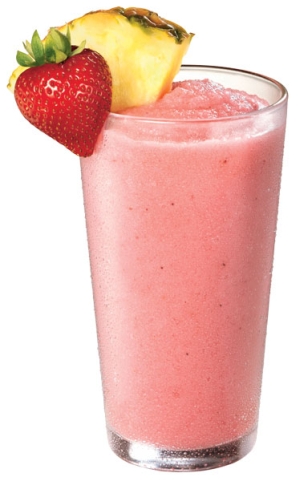 41. Smoothies
41. Smoothies
We’ve mentioned smoothies a handful of times so far.
Wonder why?
Smoothies are a quick and easy way to get the most amounts of nutrients into a portable
package.
Fruits and vegetables, in addition to dairy bases, tend to leave drinkers satisfied for longer periods of time, feeling full throughout most of the morning.
So rather than standing in front of the coffee maker in the AM and waiting for it to brew, slide down the counter and toss a bunch of delicious fruit in the blender. You’ll thank us for it later.
Power Tip: Reusable straw cups are more popular than ever. Ditch the plastic and save the Earth with some rocking designs to compliment every personality.
42. No Booze
I know, I know. After an extremely long morning we have the tendency to crave a little something stronger than coffee when we head to lunch.
But this might be zapping your productivity more than you realize.
Alcohol, scientifically speaking, is classified as a downer.
So that means the more you drink, the less productive you will be.
Sounds like a no brainer right? Wrong. A lot of companies are looking “the other way” when it
comes to employees drinking during office hours.
However, according to About.com, alcohol consumption during work hours can threaten public safety, impair job performance and result in costly medical costs.
Power Tip: Just avoid drinking during the day. During lunches, stick to water.
Music
Most people listen to music while working. Whether you use Pandora, Spotify or iTunes, the outcome is all the same: good music helps keep you focused.
Most of the time, people use music to tune out the distractions that surround them in the workplace.
43. What Type?
According to the New York Times, listening to music releases dopamine into the brain, giving it the sensation of doing something pleasurable. In other words, music makes work enjoyable!
Studies show that focus is regained after fifteen to thirty minutes of listening.
But the best music to listen to? Music without lyrics, such as classical, piano concertos or jazz.
Music with lyrics sometimes has the opposite effect, causing people to lose even more focus.
Power Tip: If you are a Pandora user, try typing in the genre you are looking to listen to. You can save these stations to your account for easy access.
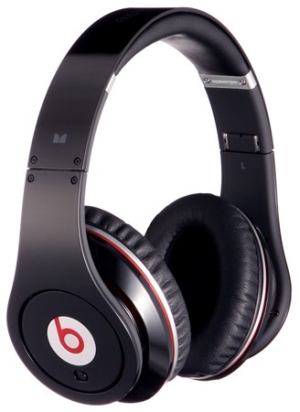 44. Earphones
44. Earphones
Everyone has a preference when it comes to the type of headphones they use.
Earbuds, over the head ones like Beats, or sporty ones that wrap around the ears.
As we said before, headphones and music can help drown out unwanted background noise and
help put your focus on more productive activities.
But which type is better for working?
Earbuds allow for quick and easy removal, while larger headphones such as the Beats block out more sound.
So if you need to be alert to your surroundings, we recommend buds.
Power Tip: Even if you don’t listen to music, keep a pair of headphones at your desk. They can help block out chatter and help keep gossipy coworkers at bay.
 45. Avoid Being a Distraction
45. Avoid Being a Distraction
We’ve all dealt with it. That one coworker who listens to music while they work, but insists on singing along with the lyrics, or even worse, playing drums on their desk with pens.
Are you that person?
While music is great for productivity, no one wants to hear your bad karaoke version of “Living on a Prayer”. Nor do they want to listen to you play the world’s longest air guitar solo, complete with sound effects.
Be respectful of those around you. Would you like it if the situation were reversed?
Probably not.
A good rule of thumb to always remember, even in this instance is the Golden Rule: Do unto others as you would have them do unto you.
In other words: just keep quiet.
Power Tip: Keep your music at a volume that is comfortable for those around you. If they can hear it through your headphones, it’s probably too loud.
Relaxation
When we think of work, a lot of us automatically tense up and become stressed at the mere mention of Monday mornings. Work can be fun, and enjoyable, when you know the tips and methods to relaxation, a key component of a healthy, productive work day.
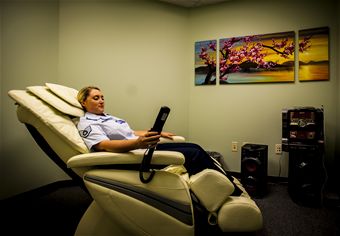 46. Relaxation Room
46. Relaxation Room
In today’s day and age, it is almost impossible to have a moment of peace to refresh and recharge after work, let alone during the hectic work day.
Some innovative companies are finding that the more relaxed employees are, the more productive they are throughout the day.
Through this theory comes the invention of the relaxation room. Relaxation rooms can contain most anything, but popular items include smooth music, aromatherapy candles and some even contain massage chairs.
Research shows that employees who take a thirty minute relaxation break return to work re-energized and use the remaining hours more productively than those who don’t take breaks.
Power Tip: Even if your company doesn’t offer relaxation rooms, try placing aromatherapy items around your office and cubicle, and take thirty minutes to lean back in your chair and relax.
47. Nap Time/Siesta
We know we can’t be the only ones who feel drained half way through the day and wish we could return to the days of preschool and nap time.
Fortunately, there are a few companies, and a lot of research, that shows a ninety minute nap halfway through the workday vastly improves productivity.
Research done has proven that a sixty-ninety minute nap improved memory test results as much as a full eight hours of sleep.
It’s all science. Humans were not meant to stretch their energy over long periods of time, making a whole work day seem like a life time.
Power Tip: Try bringing it up to human resources. They might find the research enough to make some changes and bring back the nap mats and lullabies!
 48. Meditation
48. Meditation
A lot of people tend to overlook meditation when looking to relieve stress and anxiety.
However, it can be quite a powerful tool.
In fact, research has shown that mediation helped employees concentrate better, remember more important details, stay energized and have less foul moods.
Anyone can benefit from resetting their minds.
There are a ton of websites that offer tips on mediation in the workplace, including the popular two minute mediation technique found here.
Power Tip: Instead of using break time to take a walk to the vending machine, try the two minute mediation technique. Your productivity will improve more from that then a bag of chips and a soda.
49. Deep Breathing
Sounds simple right?
Deep breathing exercises are at the core of mediation and are also the number one way to relieve stress while at work.
It also lowers blood pressure, promotes a feeling of calm and makes the body function at its best.
There are even different levels of exercises, from beginner to advanced.
We know what you are thinking. How can someone be advanced at breathing?
You can find an overview of the exercises here.
Power Tip: Take a break every hour and complete one of the exercises. It will restart the brain and make it easier to concentrate.
 50. Use A Plant
50. Use A Plant
This one might sound a little strange, but it really does have benefits for productivity.
Look around your office or cubicle. Is it pretty average and boring looking? Stark gray and unappealing?
That can be a deterrence to productivity. If you are uncomfortable with your surroundings, you won’t be comfortable to work.
Try adding a plant to your work space. Certain plants, like miniature citrus trees, give off an aroma (sound familiar?) that helps energize the mind.
Green plants add oxygen to small spaces and spaces that use recycled air, such as an office.
Power Tip: Having your favorite flower close by will immediately make you happier.
51. Shake It Out
Ever get an email from an annoying co-worker and you just feel like screaming in frustration?
Don’t worry; it happens to the best of us.
The quickest, and easiest, way to recover from that is the “shake it out” method.
It’s really easy. Stand up, walk away from the computer, and shake your body (mostly arms and head) to push the anger and frustration out of the body.
You’ll return to your desk ready to tackle the issue and with far less aggravation.
Power Tip: We recommend doing this exercise every time something irritates you. It helps. A lot.
52. Frequent Breaks
A lot of people think that in order to be productive, they must be continuously working throughout the day. More hours means more things done.
Wrong. Working hard doesn’t always mean working productively. The mind will lose focus over the long hours and will not work as effectively as it did when you first sat down.
Research shows that taking frequent breaks increases creativity and reduces stress.
We don’t necessarily mean taking a break every hour; just take the recommended lunch and morning 15 minutes. The time away from the desk will refresh the brain and re-engage your creativity.
Power Tip: Take a stroll during your breaks. Exercise increases blood flow throughout the body, naturally giving you more energy.
Vitamins and Supplements
 53. Vitamin B Complex
53. Vitamin B Complex
First, let’s tackle what exactly a Vitamin B Complex is.
According to Yahoo! Voices, a Vitamin B Complex is a combination of essential vitamins including Thiamin (B1), Riboflavin (B2), Niacin, Vitamin B-6, Folic Acid, Vitamin B-12, Biotin and Pantholenic Acid (B5). That’s a lot of vitamins.
The benefits of taking a Vitamin B Complex are huge. It helps control weight and aids in weight loss, gives you healthy looking skin and the most important benefit pertains to productivity.
Vitamin B Complex is a natural stress reliever.
The vitamins in the complex help natural, healthy body function, which in turn allows the body to create more energy. The less tired you are the better at handling stress your mind is.
Power Tip: Pop vitamins in the AM to have sustaining energy throughout the day.
54. Rhondiola
Proponents of natural medicine may already know what Rhondiola is. But if you are like a lot of Americans, you will probably Google it after reading this section.
We don’t blame you.
Rhondiola, which is sometimes referred to as Arctic Root or golden root, is an herb that acts in non-specific ways to increase resistance to stress without disturbing normal biological functions.
It’s been used for centuries for its stress reducing properties, although the FDA hasn’t approved its claims, and have removed some products from the shelves.
Power Tip: Take at your own risk. We can’t substantiate the claims of stress reduction; only tell you what we know…which isn’t much.
55. Lethicin
There is a lot of debate on whether or not Lethicin supplements are good or bad.
For now, we will stick to the benefits, rather than the negatives, should there be any.
Lethicin is a powerful antioxidant that provides its takers with increased nervous system function, lowers cholesterol and improves memory function.
This means that not only will your brain work harder and better for you throughout the day, you will also be less likely to miss work due to physical ailments.
Which means big bucks in the bonus departments.
Power Tip: Lethicin can be found naturally in eggs and soy. Eating these foods rather than taking supplements can give you the same benefits without the unpleasant side effects.
 56. Asian Ginseng
56. Asian Ginseng
Asian Ginseng is also known as Panax in medical terminology and has been used for centuries to cure various ailments.
In fact, over 6 million Americans use it each day.
When combined with Ginkgo, Ginseng (Panax) can increase mental arithmetic skills, abstract thinking and reaction time in middle aged adults.
But don’t go running into a busy intersection to test this out. Leave that to professionals.
Power Tip: Ginseng can react with certain prescription medications, so always check with a doctor before taking.
57. Bitter Orange
Bitter orange is a fairly new natural energy booster on the market.
It is a fruit made in combination of pomelo and the mandarin orange, and is often the most used orange for making marmalades. Interesting tidbit.
The extract of the bitter orange, and its rind, is similar to epinephrine and has been shown to be a powerful appetite suppressant and offers those who ingest it an energy boost as well.
But be warned: a lot of substances containing bitter orange have been removed to shelves due to a connection in strokes, angina and even death.
Power Tip: If you insist on eating bitter orange, stick to the confirmed “safe” versions, usually found in Indian food and as mentioned before, marmalades.
58. Capsaicin
This may sound slightly strange, but fiery hot peppers are actually a powerful antioxidant.
In fact, the capsaicin in peppers causes the release of endorphins, which is what produces pleasure.
Guess that’s why men love spicy food.
In addition to just being a pleasure filled fireball, peppers with high amounts of capsaicin also aid in weight loss, acting as a mild appetite suppressant.
If you suffer from body aches and pains from sitting in a desk chair and staring at a computer screen all day, there are over the counter remedies that harness the capsaicin in peppers and bottle it for a powerful arthritis reliever.
We don’t recommend rubbing a habanero pepper on your skin though. Doesn’t work the same and might cause skin burns.
Power Tip: Peppers can add a tasty kick to almost any meal. So grill them, chop them or sauté them into your favorite dishes.
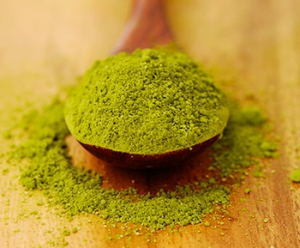 59. Green Tea Extract
59. Green Tea Extract
Green tea is probably one of the most commonly used “natural” remedy today. It can help aid in weight loss by boosting metabolism, and the caffeine in green tea is an excellent source of productivity in the workplace.
Best part? You don’t necessarily have to drink it, unlike coffee.
According to Wikipedia, one capsule of green tea extract has the same amount of caffeine as four cups of tea.
Be careful: while green tea extract has numerous benefits, it also has been linked to occasional cases of acute liver failure.
Power Tip: Mix it up! Don’t rely solely on green tea extract for your energy boosts.
60. Hidden Sources of Caffeine
We all know that caffeine is one of the best ways to give you a quick energy boost when you feel like you’re in a lull.
But did you know there were “hidden” sources of caffeine?
You would never expect there to be caffeine in decaf coffee, would you? According to Health.com, decaf coffee can sometimes contain up to 20mg of caffeine, about ¼ of a regular cup of joe.
Other surprise sources of caffeine include: non-cola sodas (root beer, cream soda, etc.), certain ice creams, chocolate, weight loss pills, energy waters, pain relievers and alcoholic energy drinks.
With all these different options, there is no excuse for the 2PM desk nap.
Power Tip: Don’t abuse caffeine. It is a stimulant and has addictive properties, much like alcohol and drugs.
61. CoQ10
We’ve discussed many various “natural” remedies throughout this list. But did you know, CoQ10 is actually produced naturally by the human body? It’s what makes our cells function properly.
This makes it a REALLY natural product!
As we age, CoQ10 production decreases, which causes our cell to deteriorate, and many other illnesses destroy CoQ10 production.
Some research has shown that proper CoQ10 levels can help fight off Alzheimer’s, angina, asthma, cancer, even migraines.
That means less sick days and more productivity!
Power Tip: Add CoQ10 to your daily multi-vitamin.
 62. Ginkgo Biloba
62. Ginkgo Biloba
Ginkgo Biloba has been used for centuries as a natural remedy, and is even one of the top selling herbs in the United States!
All those people can’t be wrong!
Ginkgo Biloba has been found in studies to prevent fatigue, dizziness, headache and depression.
It’s readily available online and in most drug and natural food stores.
Power Tip: Take caution when taking Ginkgo. Some studies have found excessive bleeding in people with anticoagulant disorders and those undergoing dental/surgical procedures.
63. Iron
When people are looking for ways to increase their productivity, then don’t generally think of iron.
But iron is a HUGE factor on energy production and use.
There have been studies done that show people who have diets supplemented with iron are more productive than those with regular diets.
This is because iron deficiency results in anemia, a blood disorder that causes fatigue and drowsiness.
Without iron, we are naturally inclined to be unproductive!
Power Tip: If you feel sluggish, try taking an iron supplement, or if you’d rather, eat foods that are high in iron such as red meat and leafy greens.
64. Zinc
Zinc is another natural element that can help boost productivity while at work. Like iron, you wouldn’t even think about zinc!
But you should.
A zinc deficiency can cause a lack of taste and smell (weird, huh?), lack of appetite, depression and frequent illnesses.
A malnourished, depressed, sick employee is not a productive employee!
Power Tip: A lot of foods are naturally high in zinc. Visit http://www.whfoods.com/genpage.php?tname=nutrient&dbid=115 to learn all of them!
 65. Magnesium
65. Magnesium
Magnesium is one of the most powerful mineral found in the body. It has a place in over 300 different bodily functions, such as muscle and nerve function, glucose control and blood pressure regulation.
And like we say, a healthy employee is a productive employee!
Various foods are rich in magnesium, almonds and spinach carrying the most abundance at 20% of your daily value.
Power Tip: Adults 30 and older need about 400mg of magnesium a day.
Tools
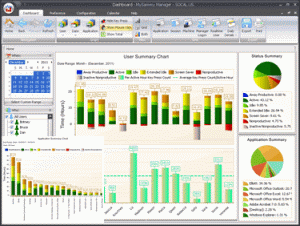 66. MySammy
66. MySammy
What did Yahoo and your mom have in common? Neither of them had a way to make sure you were actually doing your work when you were supposed to.
Then-new CEO of Yahoo Marissa Mayer banned the practice of telecommuting because she believed remote workers weren’t actually working. How did she come to this conclusion? Because they weren’t logging into their corporate VPN. That’s it.
The fact that a tech titan had to rely on such a crude measure of worker productivity shows there’s a serious problem when it comes to measuring productivity of knowledge workers.
How can you make sure an employee is in fact working when they’re supposed to? That’s where MySammy comes in. It allows both employees and managers to view stats like active versus inactive time, time using certain applications, websites visited, etc.
In other words, if MySammy shows that an employee was Inactive for a good chunk of the day, while the other part was filled with Solitaire and visits to ESPN, you can conclude they may not be fully maximizing their potential.
Power tip: Download the free smartphone app to keep an eye on workers from anywhere.
 67. Google Docs
67. Google Docs
It’s hard to believe, but as far back as the 1980’s, then chairman of Sun Microsystems Scott McNealy was touting the phrase “the network is the computer”. At the time it sounded like something out of a Terminator movie, but today McNealy looks prescient. “Shame on us for not summing it up in one word – cloud,” he concedes in a 2010 interview with Fortune.
People scoffed at the idea of doing things like Word or Excel online; Google Docs slowly but surely changed that notion.
Today it’s hard to remember a time where we didn’t have Google Docs. The ability for different people anywhere in the world to work on the same document is so incredibly valuable. No more emailing different versions of documents with confusion about what is the most recent version. Google Doc spreadsheets are fantastic for everything from project management, to massive lists and financials.
Bonus, its frequent autosaves means no more pounding your head on the keyboard because of an unsaved file.
Power tip: Remember to regularly download important Google Doc files to an actual hard drive. “Cloud” doesn’t mean indestructible.
 68. Dropbox
68. Dropbox
Remember the days of huge email attachments taking forever to load, or even more annoying, crashing your email software or computer? Before Dropbox, the only other real option to send and receive massive files was using FTP transfers that were beyond the ability of most average workers.
Then came Dropbox. Such a simple idea but such a difference it made in sharing large files.
Users simply signed up and moved files to a shared Dropbox folder which lived in the “cloud”. Others could be invited to the folder and could download it just as if it were a folder on their own computer.
Now sharing large high resolution photos and massive Powerpoint decks is a walk in the park. As a bonus it also acted as an impromptu backup for those files. File this one under “why didn’t I think of this so I could become a gazillionaire”?
Power tip: Files in your Dropbox folder take up space on your local hard drive too, so be mindful!
69. Skype
You know your company has “made it” when your name becomes a verb.
“Just Google it.” “Tweet him.” “Xerox a copy.”
Add Skype to that discussion. “Just Skype me” has become a way for people from around the world to communicate via IM, voice chat or video chat.
Yes, we know that instant messaging has been around since the dawn of the Internet. ICQ, AIM, MSN Messenger, Yahoo Messenger and the like. But somehow through it all, Skype has emerged the IM of choice for business folk. Not a lot of cute emoticons, just solid connectivity.
“I’ve heard so many personal stories of how much people love Skype and have realized Skype should be all about storytelling,” says Skype CMO Elisa Steele in an August 2013 interview.
Now anyone from India or China can Skype you at 11:30pm (or vice versa)! Yay productivity! Even better, they can see what you look like right before you go to bed.
Power tip: Use Skype on your smartphone to make cheaper long distance calls. Or check out the Line app for free voice chatting.
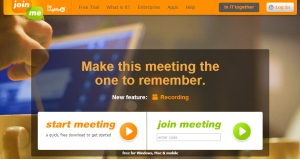 70. Join.me
70. Join.me
How many times have you been on the phone trying to describe something on your computer screen, and just wishing you could show them what you were seeing?
Join.me is a dead-simple way to do screensharing. Much easier than setting up a GotoMeeting or some of the other enterprise sharing products. And it’s free to boot.
Using it couldn’t be any simpler. One party just goes to Join.me and downloads/installs a small piece of software. They give a code to the other party. Enter the code and BAM, almost instant screensharing.
Use it once and you’ll wonder how you ever lived before without it.
Power tip: Check out their Recording feature so you can really say “I told you so” to those annoying co-workers with bad memory.
 71. Google Hangout
71. Google Hangout
Once upon a time Google wanted to create a social media platform that would be larger than Facebook.
They called it Google+ (Google Plus).
After a spurt of rapid adoption, people realized “why the heck do I want to have to check TWO social media websites every day?!” and stopped using it.
The end. Except, not quite.
Slowly but surely certain features of Google+ grew in popularity, like Google Hangout.
Think of Google Hangout like Skype video chat for a lot of people.
Add on a heap of cool features like capturing video, sharing your screen, messaging friends, posting the live video to your Google+ page, and it’s the perfect tool for instant productive collaboration.
Power tip: Use visual effects to give yourself an angel halo or devil horns to spice up any business video Hangout.
Corporate Culture
The specific culture a company sets through policy and norms can have a huge impact on the productivity (or lack thereof) of its employees.
Here are some best practices to help maximize their productivity.
72. Employee Satisfaction
A happy employee is a productive employee.
That much should be obvious. What’s less obvious is, how do you know if your employee is happy, and how can you make them happier?
One of the easiest ways to get a gauge is to conduct a short, anonymous survey. There is a monetary and time cost to conducting the survey which far outweighs the cost of having dissatisfied employees grumbling on the job.
Industry-wide surveys aren’t very promising. A 2012 survey by Right Management showed that two thirds of employees were not happy at work.
That is a stunning number.
Some questions to ascertain:
-Do employees feel a sense of pride for their company?
-Are they self-motivated to go above and beyond their hours and job duties?
-Is there strong leadership and mentoring, or is it each man/woman for themselves?
-Do they feel they share in the financial success of the company?
-Do they feel they are a valuable part of the team?
-Do they feel their contributions are recognized?
-Are there clear lines of communication between management and employees?
-Are they being challenged enough on the job to expand their skill sets?
If most of these questions can be answered in the affirmative, then your employees might also come to work saying “Thank God it’s Monday”.
Power tip: Even as far back as Elton Mayo’s studies in 1924, researchers realized that financial incentives and physical working conditions mattered less than the informal social pattern at work.
 73. Telecommuting
73. Telecommuting
While the practice of telecommuting isn’t new, never before has it been easier for workers to do their work remotely.
The bevy of tools to communicate and collaborate ensures that all employees, no matter where they are in the world, can stay in close touch.
And through a productivity measurement tool like MySammy, you can ensure accountability of every remote worker.
Studies back up the notion of more productive telecommuters:
-A 2011 study by Stanford University of a Chinese travel agency found that their remote workers took more calls, logged more hours and were overall more productive.
-Studies analyzed by Penn State also show that telecommuting boosts productivity, performance, job satisfaction and overall life satisfaction.
-“Companies that have embraced telecommuting have found that their remote workers are just as, if not more productive than traditional office workers. Analyses of Best Buy, British Telecom, Dow Chemical and many other employers have found that teleworkers are 35 percent to 45 percent more productive. American Express found that its teleworkers produced 43 percent more than their office-based counterparts,” according to John Challenger, CEO of Challenger, Gray & Christmas, Inc.
Telecommuting can even be used as the “carrot” to incentivize workers to be more productive, as this case study shows.
Power tip: Not all employees are cut out for telecommuting. Create flexible work arrangements that match individual work patterns.
74. Positive Environment
It’s a rare occasion that someone finds their dream job and they never dread going into the office.
However, for most of us in jobs that we do because, well, we have to, a positive work environment can make going to work a lot easier.
The more dissatisfied you are at work, the less productive you will be.
According to the New York Times and Gallup, employee dissatisfaction costs employers $300 billion a year in lost productivity.
Creating a fun, positive environment isn’t difficult and you don’t have to go to the lengths that companies like Google does.
Power Tip: This one is for management. Create fun events once a month to inspire creativity and teamwork. More fun equals more satisfied employees.
75. Rewards
Since we were toddlers, we’ve been persuaded to do things from using a toilet, to picking up after ourselves, with positive reinforcement. Remember when you got a sticker on a chore chart or got an ice cream cone when you did well at baseball practice?
Well, the corporate environment isn’t much different from our kitchen tables and bedrooms.
When we do well at work, a lot of employers choose to reward us with more adult “prizes”: more vacation days, gift cards, employee of the month awards, etc.
According to Workforce Management, money is not an effective motivator in numerous cases.
Rewards should not be equated to compensation in order for the employee to be motivated to increase productivity.
There are many ways to reward employees, from the free, to the not-so-free. You can read more about them here.
Power Tip: If your company doesn’t offer rewards, try rewarding yourself. Set goals for yourself and rewards for each.
 76. Punishments
76. Punishments
Like we said in previous topics, the corporate environment isn’t much different than our homes and responsibilities as a child.
When we did something wrong, we got punished. Same goes for the workplace.
Most companies judge their employees by productivity, sales, and basic job duties.
Unfortunately, according to The Atlantic, punishment is a heavier motivator than rewards.
Fear has always been the best form of motivation: “It is better to be feared than loved” from Machiavelli, the Prince.
Performance reviews and employee computer monitoring are quickly becoming the most used ways to measure employee productivity.
Just make sure you do your work if you don’t want a spanking.
Power Tip: There are online monitoring programs that are beneficial for self monitoring. It will save you from any surprises come review time.
77. Feedback
Everyone likes to know when they have been doing a good job, and some, if you are masochistic, like knowing when they are doing a subpar job.
Luckily for us, most companies offer their employees feedback along the way.
Usually, feedback in the corporate culture is the good old performance review.
We all get them. Every couple of months we are called into an office or conference room with some mid-level manager to discuss our “pros and cons”.
Have you ever noticed a lot of them employ the “Sandwich” method of review? Compliment, followed by the negatives, ended with another compliment.
Supposedly, this softens the blow.
According to Entrepreneur Magazine, there are easy ways to make the feedback process a more positive experience.
But we will still cringe when our names are called.
Power Tip: Learn to take constructive criticism. If you don’t take offense to everything that is said to you, it makes the process go a lot more smoothly.
78. Balancing solitary and group activities
In today’s day and age of constant meetings, conference calls and the never-ending drumbeat of “collaboration”, something that often gets lost in the conversation is the benefit of working alone.
For all the hype that outgoing, extroverted risk takers get, maybe we should also consider the fact that just as many people are introverted and prefer solo tasks versus constant group interaction.
The trendy push for “open” office work spaces sounds very progressive and hip, but in fact are associated with reduced concentration and productivity, impaired memory, higher turnover and even increased illness(!).
This is likely due to the fact that research from the University of Calgary found that just having someone working on a different task in your field of vision was enough to slow down your performance.
But this doesn’t mean that we should all return to our silos; far from it.
Decide which types of tasks are best suited for group collaboration, for example research teams working on complex engineering, scientific or medical problems.
But also carve out enough time for employees to spend on their own, free of distraction, to dedicate a period of time and really think things through.
Clive Thompson makes a great point in a Wired article that “one-size-fits-all policies are too crude for today’s white-collar toil”. He suggests that organizations understand the subtleties of different requirements for different tasks, and allow workers the flexibility to flow with them.
Power tip: Staggered work arrangements that require both facetime and solitary/remote work can be the best of both worlds.
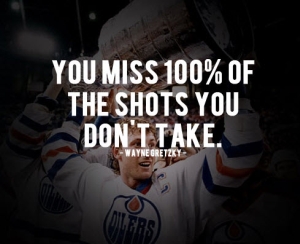 79. Risk Taking
79. Risk Taking
Sometimes in life, you have to take risks. Or so we are told.
But often times, risks can equate to personal successes.
Without taking risks in the workplace, we would not have some of the inventions that we have today. Google even pays their employees to take risks and create new innovations.
If you don’t work for Google, or a company like theirs, that doesn’t mean you shouldn’t take risks. Ask for that promotion, raise or pitch a crazy idea. You never know what can happen!
From an organizational standpoint, not taking risks can lead to a slow (or fast) death, especially in an industry with rapid product cycles.
“The Innovator’s Dilemma” by Clayton Christensen was published in 1997 and perfectly encapsulated the problem companies face. They thrive off what made them successful, leaving them blind and vulnerable to upstart competitors that are willing to take risks. In essence, their market leadership leaves them risk-averse.
“You can’t score if you don’t shoot” said legendary soccer player Johan Cruyff, or another way of saying it is “you miss out on 100% of the shots you don’t take” said legendary hockey player Wayne Gretzky.
Power Tip: No risk, no reward. To the victor go the spoils. There are dozens of quotes about the benefits of risk taking. Go in with eyes wide open and take a calculated chance.
 80. Higher Purpose
80. Higher Purpose
Sure, most people work because they have to. What this means is, they work because they have a financial need for a paycheck.
But this doesn’t automatically mean that the only reason people want to work is to make money.
This is why people say “you may work for money, but you live for meaning”.
Humans have an intrinsic need to feel worth. We all want to feel as if we are contributing to something bigger than ourselves.
And in fact almost every job we do has a meaningful impact on someone, somewhere. No matter if an employee is on the front line servicing customers or in a backroom processing payment requests, their ability to do their job effectively has a material impact on someone else.
The most progressive companies like Google instill an even deeper philosophy that their work impacts the world at large. But you don’t have to be an advanced technical company like Google to convince your employees that their work matters.
Regardless of what your company does, you can instill in your employees from Day 1 that their work means something and is important. They are important. Their job is important. Do it with pride.
I’m reminded of a scene from the movie “The Last Samurai” where the main character Nathan Algren marvels at the Japanese work ethic that he sees:
“I have never known such a disciplined people. From the moment they wake, they devote themselves to the perfection of whatever they pursue—“
Power tip: Let us all pursue perfection of whatever it is we do, to the benefit of our company, our customers and the world.
81. To Multitask or Not to Multitask
If you’ve ever bragged about your multitasking abilities to others, it might be time to rethink things.
There are loads of research on how multitasking is not only beneficial, but it might actually be bad for you.
Peering at brain activity as people multitask shows that we end up overloading the brain’s capacity, according to research from Massachusetts Institute of Technology neuroscientist Professor Earl Miller.
A University of Utah study of 275 undergrad students found that many people don’t multitask to boost productivity but instead do it because they lack the ability to focus.
Another study from Ohio State University suggests that although people perform worse from a productivity standpoint when they multitask, they feel good.
And no, just because you grew up in the age of texting, IMing, gaming and talking at the same time doesn’t mean your brain is any better at multitasking.
So how can you break free of the multitasking myth? Try the “singletasking” workflow that Leo Wildrich suggests in Lifehacker. Focus on just one task, with no more than one web browser open, and a list of to-dos for the day that you quickly go over with someone. Hey, it works for him.
Power tip: Try and catch yourself whenever you think you’re “multitasking”. Close all distractions—emails, IMs—and try to focus on the task at hand.
 82. Quantify Diligence
82. Quantify Diligence
The difficulty in most areas of work is in how to quantify performance.
For some types of work, this is easy. Sales are expected to hit a certain quota every month. Processors are supposed to process a certain number of applications per hour or per day. Accountants are supposed to find ways to minimize taxes or reduce costs, along with those in Finance.
But what about other types of work where it isn’t so easy to figure out what exactly the employee is supposed to strive for in terms of goals?
Take a software engineer or coder as an example.
Is it the total number of lines of code? Simply measuring performance by quantity of code written is not a good idea. Many times, the best code is the simplest code.
Is it by the number of bugs? Sure, quality control is always good. But there are serious bugs and there are cosmetic bugs.
Perhaps the best way to quantify productivity is to measure an employee’s “diligence”.
Diligence simply means persevering, attention and care.
Read more about how to apply measuring diligence at this article here.
One of the best ways to measure diligence is with a tool like MySammy. With software like this, you can view the percentage of computer activity time, what applications are in use, the keystrokes per minute and the intensity of the activity.
All this can be used to paint a picture of how diligent a worker is. And as diligence increases, so should productivity.
Power tip: Change the mentality from a “clock in, clock out” attitude to a “diligent” attitude for your employees.
83. Setting Goals
As the old saying goes, how can you arrive at your destination if you don’t know where you are going?
In order to maximize the engagement of your employees, follow these steps in setting goals with them:
-Ensure that their goals are aligned to some degree with the greater goals of the organization. If employees can internalize that their work is important to the company’s success, they will be far more motivated. And a motivated employee is a productive employee.
-Find the right balance between goals that they can meet and goals that are challenging. You don’t want them to be bored because the goals are too easily attained, nor do you want them to give up before they start because the goals are too unrealistic.
-Find out what their personal goals are. Do they want to learn more about a new particular field? Are they aspiring to get promoted? Would they be open to continuing education?
Remember to care for the employee as a person, and they will care for the company.
-Monitor progress on a regular basis. Quarterly reviews are great but may be too far apart be meaningful. Short meetings every week can help make sure adjustments can be made before it’s too late.
-Use the SMART approach (Specific, Measurable, Attainable, Relevant, and Time Focused).
-Looking into RDM (Ratings Distribution Management) to calibrate ratings across an organization.
-Consider P4P (Pay-for-Performance) to create a culture of high performance.
Power tip: “A good hockey player plays where the puck is. A great hockey player plays where the puck is going to be.” –Wayne Gretzky
Sleep
Ah, blessed sleep. We all need it, yet scientists can’t really explain exactly why.
Regardless, it’s a well-known fact that a good night’s sleep is critical to physical and mental well-being, thereby playing a major role in one’s productivity.
Here are some useful tips to make sure you sleep soundly.
84. Sleeping Enough Hours
In a 2012 study by the Centers for Disease Control (yup, that’s how serious they view it), 30% of US adults report sleeping six or fewer hours per night, less than the recommended seven to nine hours.
This has had serious consequences in our work-first society. Besides the decreased level of productivity, lack of sleep can lead to serious accidents either in the workplace or while driving.
“We continue to live by a remarkably durable myth: sleeping one hour less will give us one more hour of productivity. In reality, the research suggests that even small amounts of sleep deprivation take a significant toll on our health, our mood, our cognitive capacity and our productivity,” says Tony Schwartz, president and CEO of the Energy Project.
When researchers put test subjects in a setting that didn’t have clocks or windows or any other ways to measure time or time of day, they found that a shocking 95% slept between 7 and 8 hours out of a day.
What this means is that since 30% of us are sleeping six or fewer hours per night, that’s a huge amount of people that are piling up “sleep debt”.
Power tip: Not only try and get 7 to 8 hours of sleep per night, try and catch up on “sleep debt” during weekends.
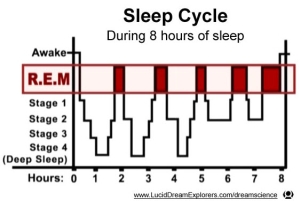 85. Quality of Sleep
85. Quality of Sleep
“Quality, not quantity” is one of those sayings we hear all the time.
This applies in spades to sleep as anyone who has spent a restless night tossing and turning can attest.
While we still don’t know exactly why we need sleep, we do know that we need it, and need good quality sleep.
The quality of one’s sleep is directly related to the stages of sleep that everyone goes through in a typical night, and it affects all parts of our brain and body:
Stage 1 and 2 – light, early stages of sleep. If you wake someone up during these stages, they’ll tell you they weren’t even asleep.
Stage 3 and 4 – characterized by delta waves, the slowest brain waves. Deep sleep, the part when it’s hardest to wake someone.
REM (Rapid Eye Movement) – the stage where dreaming occurs.
People who get insufficient deep sleep and/or REM sleep are the ones getting “poor” quality of sleep.
Power tip: Adjust your alarm clock to wake you up on at a 90 minute multiple. So if you went to bed at 11pm, try and wake up at 6:30am (instead of 7 or 7:30). This keeps you in synch with the average length of a sleep cycle.
86. Mattress
What one item do we spend most of our lives on?
It’s an obvious answer since this falls under the heading of “mattress”.
Think about it. You spend a quarter to a third of the hours in a day lying on a mattress. Yet most people barely give it a second thought.
restful night’s sleep. And that directly impacts your productivity.
Listen to what Theresa Y. from Vancouver, BC had to say:
“I would wake up frequently at night and have trouble falling back asleep. Daytime drowsiness and the need for a nap was common even after getting eight hours of sleep.
This was with a pretty decent pillow top mattress that was about eight years old. A trip to a local mattress store convinced me to purchase the Dormeo mattress that was a sort of hybrid between a pure memory foam mattress like Temper-Pedic and a traditional box spring mattress.
The result has been day and night. The firmness but support of the Dormeo gives me the perfect amount of support. I sleep like a log through the night and have so much more energy during the day. It’s literally been a life-saver.”
This isn’t to say that a memory foam mattress is right for you. If you tend to get hot when you sleep, you may find memory foam simply too warm.
Here are the four main considerations for when you go mattress shopping:
1. Price – what’s your budget? Good mattresses aren’t cheap, but if you amortize it over the years you’ll use it…well, let’s just say that a good night’s sleep can be priceless.
2. Comfort – do you like it firmer or softer? Memory foam or traditional? Where do you need the extra support?
3. Size – twin, queen, king?
4. Durability – you get what you pay for. Cheap mattresses will have you dying to get another one in a year or two.
Power tip: Remember most mattress stores have a period of time you can return your purchase if it isn’t right.
87. Melatonin
Melatonin is a naturally occurring hormone of the human body that helps regulate its circadian rhythm and the sleep-wake cycle.
As such, it is one of the first supplements people turn to when they face sleep issues. These might include jet lag, adjusting to different sleep schedules for those that work varying day/night shifts and the all-encompassing condition of insomnia.
However, the research to support how well melatonin actually helps with various sleep issues is a bit muddier. Many studies show that melatonin doesn’t fare much better than a placebo. Others show modest gains in helping certain aspects of sleep and not in others.
Our bodies start to pump out the stuff as the sun goes down, generally starting around 9pm, and ceases producing it completely during the daytime.
So is melatonin right for you? The only way to find out is to give it a try, but as with all health supplements, check with your doctor first.
Power tip: One interesting factoid is that melatonin only is released in the dark, thus earning it the nickname of “Dracula of hormones”.
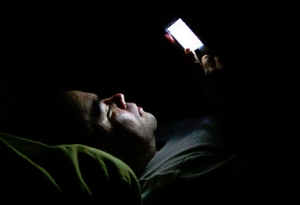 88. No electronics before bed
88. No electronics before bed
If you end your day the same way you started your day—by checking emails or surfing the web on a smartphone or tablet—you’re not alone.
And if you’re ashamed to say that you check your phone in the middle of the night when you wake up, you’re also not alone.
A 2012 survey by Lookout found that 54% said they check their phones in bed before they went to sleep, after they woke up and even in the middle of the night.
If you’ve also noticed a connection between constant checking of the phone and a decline in your sleep quality, you’ve experienced something that the American Medical Association recognizes as a problem: sleep loss linked to “blue light” emitted from many handheld devices.
Blue light also suppresses the hormone melatonin, critical for proper sleep regulation.
All in all, constantly checking smartphones and tablets before bed is not a good way to ease into la-la land.
Instead, try reading an old fashioned book, listening to music or praying.
Power tip: Check out the products at LowBlueLights.com for ways to reduce blue light exposure.
 89. Avoiding alcohol and caffeine
89. Avoiding alcohol and caffeine
It’s a common misconception that alcohol is beneficial to a good night’s sleep.
In fact, alcohol disrupts sleep patterns and contributes to waking up a night. Persistent use of alcohol can take away the slow-wave sleep that is so crucial to a good quality night’s rest.
And to top it off, we all know the effects of too much alcohol on the next day’s hangover…definitely not conducive to productivity.
So skip the nightcap for something healthier. Warm milk, anyone?
We all know that you shouldn’t drink caffeine before bed. But did you know that caffeine has a half-life of almost 6 hours? Half-life simply means how long before your body has half the original amount. Thus if you ingested 200mg of caffeine at 6pm after dinner, your body still retains about 100mg of caffeine at midnight.
So calculate what’s the latest you should be drinking that cup of coffee in order to not disrupt your bedtime schedule.
Power tip: Try a bevy of different herbal teas to help you unwind before bed, such as Chamomile, Peppermint Herb, Lemon Balm, St. John’s Wort, or Sage.
90. Checking for sleep disorder
If all of these tips for a good night’s sleep have failed, it’s time to get some medical attention.
The first step is to rule out other potential physical conditions that are affecting your sleep, including chronic illnesses such as diabetes, arthritis, HIV/AIDS, lupus, Parkinson’s disease and others.
Next up are sleep-specific disorders: chronic insomnia, sleep apnea, restless leg syndrome, parasomnia (sleep walking disorders) and Circadian rhythm disorders.
Once a physical cause for sleep disorder is identified, then a course of treatment can be started, often with great rates of success.
Power tip: Don’t put off discussing your sleep issues with your physician.
Emails
 91. Inbox Zero
91. Inbox Zero
Do you remember what life was like when your Inbox was completely empty?
Me neither. It was probably the first time you installed Outlook or whatever email client you use.
These days, despite our best intentions, inboxes are flooded with a non-stop barrage of emails.
Despite it seeming like an impossible goal, many companies have taken on the challenge of helping those get to an “inbox zero”.
Courtesy of KernelMag.com
Alto is a free service built by AOL, still in beta mode, that works to sift through your email and put them in virtual “stacks” based on their categories or ones you create. Cool “Snooze” feature temporarily gets rid of it until later.
Sanebox helps move “unimportant” emails into their own folder and summarizes them in a digest format. Its criteria is the email’s past interaction with your inbox. Cool features include one-click unsubscribes (yay!) and SaneAttachments which moves large attachments out of your inbox and into cloud services like Dropbox. Plans start at $2 per month.
Mailstrom is a bit more complex, leading to a love-hate relationship for some. Its main selling point is in sorting emails and allowing different types of views in the main dashboard, but one of its biggest limitations is not being able to see which emails are read or unread. Free service.
Inky is a beautiful looking software that you have to download, so it would replace Outlook. One neat feature is, like its name, Inky will tag emails with blue drops. The darker, the more important.
Power tip: Everyone’s email habits are different, so find the tool that fits your needs the best.
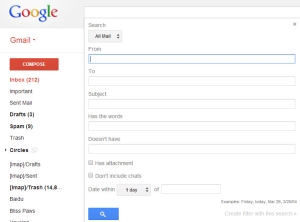 92. “Who Cares” Inbox
92. “Who Cares” Inbox
There are those who hate the entire inbox zero movement. For them, on the other end of the spectrum is the “who cares” inbox.
This applies mostly to users of Gmail. Gmail’s original intention was to change the way we used and searched for email.
In essence, it doesn’t matter what your inbox is like because you can use search to find anything you want.
There is a sense of liberty in throwing up your hands and deciding once and for all not to over-manage your Inbox.
On the other hand, some may find the Search feature on Gmail perplexing and never quite returning the results they want. Others may still be married to the folders view in a client like Outlook.
Power Tip: Use Gmail’s advanced search features to narrow down your emails.
93. Touch It Once
How many times do you find yourself re-reading the same emails again and again?
Think about how much time you spend reading an email without taking action, then multiply that out by all the emails you do this for.
Over a year, that’s a heck of a lot of wasted time (don’t even think about what that adds up to over your lifetime).
Here’s a technique that takes some discipline but will help you manage email timesucks: touch an email only once and do something with it.
-Reply with an answer if there is a question, and delete it.
-Move informative emails to a specific folder.
-If you must, move emails that will require more time to craft a thoughtful reply to its own folder.
-If there are emails, especially ones you opted-in to, that you never seem to do much with, simply delete them and Unsubscribe.
Power Tip: Use the “Unread” highlight for whatever program you’re using for emails that you haven’t touched yet.
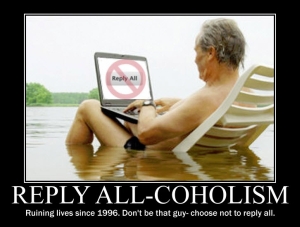 94. Less CCing and “Reply All”
94. Less CCing and “Reply All”
One of the biggest offenders of email etiquette and a major drain on productivity is ccing (which stands for carbon copying) too many people on an email.
Sometimes it’s done to CYA (Cover Your Ass).
Other times it’s to escalate something (ccing someone’s superior).
And often it’s just to prove to your boss that you’re working hard (suck up).
Add to that coworkers who love to hit Reply All, and you have a recipe for email disaster.
Especially egregious are the Reply All emails with such useful gems as “Got it”, “Thanks”, “Good points”.
Let’s not forget the unforgettable moments when someone hits Reply All with a completely inappropriate comment that they meant for someone privately. That opens up another can of worms entirely.
Don’t CC or Reply All unless really, absolutely, 100% necessary. Even then it might not be needed.
Power tip: Check out Sperry Software’s “Reply to All Monitor” for Outlook.
95. Pick Up the Phone
Let’s face it, email as a medium for properly communicating information is sketchy at best.
How many times have we run into situations where a curt email was misinterpreted by one of the parties? “Good luck with that”. What that sincere or sarcastic?
And your odds of correctly figuring out the tone of an email message? No better than a coin flip: 50/50.
In order to avoid offending someone, just pick up the phone and call.
Some people have gotten to the point where they almost view the phone as an antiquated method of communication, preferring the more passive emailing or texting.
But a simple phone call can help defuse any potential misunderstandings and nip flame wars in the bud.
And it can keep your Inbox cleaner.
Power tip: Use emails instead of the phone if you want to leave a paper trail, or get someone “on the record” about something.
 96. Set Times for Emailing
96. Set Times for Emailing
We’ve all experienced it. Just as we’re getting into the swing of a particular task, the ding of an email notification jars us out of our rhythm and we see the pop up in the lower righthand corner.
Unable to resist, we click to read and respond to the message. That leads us down a completely different path, and pretty soon any rhythm you had is lost.
Science backs this up as well. A study by the University of California Irvine found that those who were exposed to a steady stream of email messages had a higher heart rate and stayed in constant “high alert” mode than those who didn’t.
According to Guy Winch, author of “Emotional First Aid: Practical Strategies for Treating Failure, Rejection, Guilt and Other Everyday Psychological Injuries”, switching back and forth between several tasks actually wastes productivity because your attention is expended on the act of switching gears and you never get fully "in the zone" for either activity.
The best way? Set specific times to email and close your program during the rest of the time. Try first thing in the morning, once around lunch and once at the end of day.
Power tip: Depending on your job duties, pick the right times of days that fit your needs the best.
97. Avoid Rapid Responses (And Expecting It)
Everyone’s experienced the feeling. You crafted an important email and hit Send. Now you wait. And wait. And wait.
Hmm. Did it end up in their Spam folder? Did they read it and just not respond? Are they too busy for me?
All these questions start to swirl, and the more important the email, the more anxious you might feel.
But most people have legitimate reasons why they don’t respond, such as lack of time or too many emails. Then they may also have a fear of commitment or a fear of saying no.
Then there’s the times when we get an email that makes us mad, and we pound out a response quickly in the heat of the moment and hit Send. Then we think “uh oh”.
Make it a point to take time before responding to emails that are critical. Even sleep on it if you need to. Whatever you send becomes permanent, just like whatever you say to someone can’t be taken back.
Remember the saying “loose lips sink ships”? These days, loose emails can sink lives.
Both of these scenarios can suck up an enormous amount of your productive time worrying about unproductive matters.
Power tip: Use our previous tip and call the other party rather than spend too much time trying to play guessing games about their intentions.
Napping
 98. Eliminating the Stigma of Naps
98. Eliminating the Stigma of Naps
Heard of National Napping Day? If you haven’t, you’re not alone. Still, advocates of naps hope that its message will continue to spread in countries where napping is still associated with images of a worker goofing off and loafing. (It’s March 11th, by the way).
The stigma of naps in the West is a bit odd considering the practice of “siestas” has been widespread in much of the rest of the world, spanning at least hundreds of years.
Siestas are common in Latin American countries; European nations like Spain, Italy, Greece; Asian countries like China, India, Taiwan.
The problem is a real one to the productivity of workers. Almost half (43%) of Americans between 13 to 64 years old responded that they rarely or never get a good night’s sleep on weeknights, based on a 2011 poll conducted by the National Sleep Federation.
So how can companies eliminate the stigmas of naps? Change the company culture.
Educate workers on the historical luminaries who were advocates of naps, such as Winston Churchill, Thomas Edison, Bill Clinton, Ronald Reagan and even Napoleon Bonaparte.
Image courtesy of http://www.artofmanliness.com/2011/03/14/the-napping-habits-of-8-famous-men/
There’s no doubt about it. For many people, a power nap is the perfect bridge between two halves of a long and grueling day. Research has repeatedly shown that naps can help improve your alertness, memory and learning, creativity, mood and ultimately productivity.
99. How Long to Nap
The question of how long to nap for is more complicated than it seems.
Taking into account circadian rhythms, sleep cycles and a person’s unique physiology means there is no one-size-fits-all answer.
Nap too long and you might end up groggier than before you slept, a “nap hangover” of sorts. Some get headaches from napping too long.
Research from Dr. Sara Mednick at the University of California Riverside shows that different increments of naps might be selected depending on your goal:
-For quick boosts to improve your alertness: 10 to 20 minute power nap.
-For cognitive memory processing: 60 minute nap (slow wave sleep helps).
-For creativity, emotional and procedural memory: 90 minute nap (allows for REM sleep and a full cycle of sleep).
Other research such as from the University of Australia calls for sticking to a shorter 10 minute nap which “packs the most punch”.
And for those who tend to nap regularly, they show the ability to stay in light sleep versus those who aren’t used to napping who would slip into deeper stages of sleep.
The best times? You got it. It’s that time of day when you start feeling sleepy, normally between 1pm and 4pm.
Power tip: You know your body best. Pick the length of napping that fits your needs (and your boss’).
 100. Where to Nap
100. Where to Nap
Determined nappers will always find a place to nap, as this slideshow demonstrates.
Image courtesy of Huffington Post
For those of us who choose not to nap in the trunk of a police car, here are some other suggestions:
-Your desk: In Asian countries it is common for students and workers to put their heads down and take a quick snooze. Dangers: pooling saliva on your work, red side of face from sleeping on it.
-Library: Ahhh, where else can you find that is so quiet? The hush of a library is the perfect recipe for a nap. Not all libraries let people sleep at the tables though. Dangers: getting smacked with ruler by librarian, snoring too loud.
-Your car: Have car, will nap. Simply recline the seat, put up your sunshade for the windshield and pop on some sunglasses. Dangers: getting a tan or roasting if it’s too hot.
-Public transit: Something about the swaying motion of a subway or bus can lull the most stoic of us to la-la land. Dangers: ending up 30 miles away from work, waking up on the shoulder of a creepy stranger.
-Public waiting area: In a pinch for somewhere outside the office to get some shuteye? Try the lobby of a hotel or the waiting area of a train station. Dangers: being mistaken for a passed-out drunk.
-Your home: If you work close to or from home, napping on your own couch or bed might be a tantalizing possibility. Dangers: your comfy bed makes you sleep 3 hours.
-Company nap rooms:
More and more companies are taking naps seriously.
While a 2011 survey found that only 6% of companies polled had nap rooms, a separate poll in that same year found that 34% said their employers allowed them to nap at work while 16% said their employers also have designated napping areas.
Arianna Huffington promoted their NapQuest rooms stocked with Energy Pods at the headquarters of AOL and Huffington Post.
Other progressive companies like Google, Zappos and Nike have dedicated rooms for zzz’s, with couches, beds and pleasant music. No word if teddy bears are handed out.
Power tip: If all else fails, try the bathroom stall. Seriously.
101. Tools to Wake Up
OK so falling asleep isn’t the problem, now you have to think about how to avoid snoozing wayyyy past your lunch break.
If your company is lucky enough to spring for one of those Energy Pods, never fear, their timers will get you up and moving when it’s time.
For the rest of us who don’t work at Google, Zappos and Nike, and if your boss isn’t too keen on the $795 per month rental fee, it’s time to turn to other solutions.
The most obvious one is your smartphone. Set your timer to however long you need to nap, and be careful not to turn it off when it sounds and go right back to sleep. Forcing yourself to get up and back to work will be a discipline that may take practice for some.
If you have an assistant or friend or co-worker who is reliable, try asking them to rouse you from your slumber if you’re particularly hard to wake up.
Other creative solutions include odd activities such as holding a pen in your hand and waking it when it falls (supposedly about 10 minutes, the time for a short power nap).
Power tip: Practice enough and your body’s internal clock just might wake itself up. But if it doesn’t, don’t blame us.


